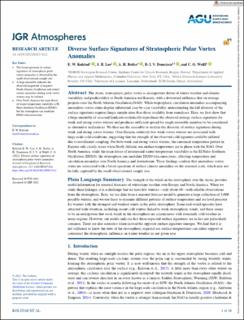| dc.contributor.author | Kolstad, Erik Wilhelm | |
| dc.contributor.author | Lee, S.H. | |
| dc.contributor.author | Butler, A.H. | |
| dc.contributor.author | Domeisen, D.I.V. | |
| dc.contributor.author | Wulff, C. Ole | |
| dc.date.accessioned | 2023-01-25T07:17:14Z | |
| dc.date.available | 2023-01-25T07:17:14Z | |
| dc.date.created | 2022-10-28T11:06:56Z | |
| dc.date.issued | 2022 | |
| dc.identifier.citation | Journal of Geophysical Research (JGR): Atmospheres. 2022, 127 (20), . | en_US |
| dc.identifier.issn | 2169-897X | |
| dc.identifier.uri | https://hdl.handle.net/11250/3046031 | |
| dc.description.abstract | The Arctic stratospheric polar vortex is an important driver of winter weather and climate variability and predictability in North America and Eurasia, with a downward influence that on average projects onto the North Atlantic Oscillation (NAO). While tropospheric circulation anomalies accompanying anomalous vortex states display substantial case-by-case variability, understanding the full diversity of the surface signatures requires larger sample sizes than those available from reanalyses. Here, we first show that a large ensemble of seasonal hindcasts realistically reproduces the observed average surface signatures for weak and strong vortex winters and produces sufficient spread for single ensemble members to be considered as alternative realizations. We then use the ensemble to analyze the diversity of surface signatures during weak and strong vortex winters. Over Eurasia, relatively few weak vortex winters are associated with large-scale cold conditions, suggesting that the strength of the observed cold signature could be inflated due to insufficient sampling. For both weak and strong vortex winters, the canonical temperature pattern in Eurasia only clearly arises when North Atlantic sea surface temperatures are in phase with the NAO. Over North America, while the main driver of interannual winter temperature variability is the El Niño–Southern Oscillation (ENSO), the stratosphere can modulate ENSO teleconnections, affecting temperature and circulation anomalies over North America and downstream. These findings confirm that anomalous vortex states are associated with a broad spectrum of surface climate anomalies on the seasonal scale, which may not be fully captured by the small observational sample size. | en_US |
| dc.language.iso | eng | en_US |
| dc.rights | Navngivelse 4.0 Internasjonal | * |
| dc.rights.uri | http://creativecommons.org/licenses/by/4.0/deed.no | * |
| dc.title | Diverse Surface Signatures of Stratospheric Polar Vortex Anomalies | en_US |
| dc.title.alternative | Diverse Surface Signatures of Stratospheric Polar Vortex Anomalies | en_US |
| dc.type | Peer reviewed | en_US |
| dc.type | Journal article | en_US |
| dc.rights.holder | © 2022, the authors | en_US |
| dc.description.version | publishedVersion | en_US |
| cristin.ispublished | true | |
| cristin.fulltext | original | |
| cristin.qualitycode | 2 | |
| dc.identifier.doi | 10.1029/2022JD037422 | |
| dc.identifier.cristin | 2065962 | |
| dc.source.journal | Journal of Geophysical Research (JGR): Atmospheres | en_US |
| dc.source.volume | 127 | en_US |
| dc.source.issue | 20 | en_US |
| dc.source.pagenumber | 16 | en_US |
| dc.relation.project | Norges forskningsråd: 309562 | en_US |

